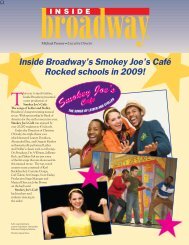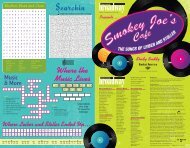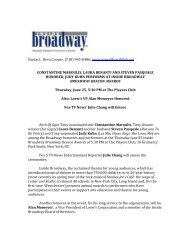Duke Ellington, Sophisticated Ladies - Inside Broadway
Duke Ellington, Sophisticated Ladies - Inside Broadway
Duke Ellington, Sophisticated Ladies - Inside Broadway
Create successful ePaper yourself
Turn your PDF publications into a flip-book with our unique Google optimized e-Paper software.
<strong>Sophisticated</strong> <strong>Ladies</strong><br />
On <strong>Broadway</strong><br />
A collection of songs by <strong>Duke</strong> <strong>Ellington</strong>, <strong>Sophisticated</strong> <strong>Ladies</strong><br />
opened on <strong>Broadway</strong> at the Lunt-Fontaine Theatre on March 1,<br />
1981.. The production which starred Gregory Hines, won 2 Tony<br />
awards and ran had 767 performances. <strong>Sophisticated</strong> <strong>Ladies</strong><br />
was not a traditional “book” musical, it was a “musical revue”<br />
which simply meant that it had only singing and dancing and no<br />
storyline. The show used tap, swing and jazz dance to help tell<br />
the “story” through song. Some of the songs in the show were;<br />
“It Don’t Mean a Thing (If It Ain’t Got That Swing)”, “Hit Me<br />
With a Hot Note and Watch Me Bounce”, “Take the A Train”,<br />
“Don’t Get Around Much Anymore”, “I’m Beginning to See the<br />
Light” and “Satin Doll”.<br />
Jazz Hot<br />
What exactly is Jazz and where<br />
did it come from?<br />
An original American artform, Jazz music was created in New Orleans around the turn<br />
of the century by African Americans with its roots based in ragtime, blues and spirituals.<br />
The cornerstone of Jazz is improvisation which lets the musician “make up” their own<br />
notes and rhythms so that the music sounds spontaneous and new. While Jazz started<br />
around the turn of the 20th Century, its popularity reached its height in the 1920’s and<br />
30’s as the Great Depression plunged many into economic hard times. While people<br />
could not afford to go to clubs and shows, they could listen to the radio at home for<br />
free. Jazz not only survives these decades, it flourished and became even more popular<br />
with the public. As Jazz music spreads across the country, it changed slightly from region<br />
to region, from the urban sound of Chicago Jazz, to the loose, spontaneous swing of<br />
Kansas City Jazz. Even with all of the different “improvisations”, Jazz becomes a recognized<br />
style that is still changing and thriving today.<br />
To Learn More About…<br />
Black<br />
Swan<br />
Records<br />
Founded by Harry Herbert Pace in 1921, Black Swan Records<br />
became the first African American owned recording company<br />
in the United States. The company’s first office was located at<br />
257 West 138th Street, which also happened to be Harry Pace’s<br />
home. The name “Black Swan Records” was chosen to honor<br />
the accomplishments of Elizabeth Taylor Greenfield, a talented<br />
African American singer know as “The Black Swan”.<br />
With the signing of a young singer by the name of Ethel Waters,<br />
Pace turned the record label into a success that led to the<br />
purchase of a building on 135th Street and Seventh Avenue that<br />
employed 30 people in its offices and shipping rooms. By this<br />
time, Black Swan had expanded its recording and selling of music<br />
to various genres including opera and symphony orchestras.<br />
In 1922, Black Swan Records found it increasingly hard to sign<br />
Black artists for its roster as record labels such as Columbia, Okeh<br />
and Paramount began to see the benefit in producing Jazz and<br />
Blues records and began to pursue these artists. Around this time<br />
the popularity of radio broadcasts came about which hurt record<br />
sales around the country.<br />
In December of 1923, Black Swan Records declared bankruptcy<br />
and in 1924, leased the song catalog to Paramount Records.<br />
The Harlem Renaissance visit www.jcu.edu/harlem/index.htm<br />
Tap Dancing visit http://atdf.org<br />
Jazz Music visit http://www.pbs.org/jazz<br />
The New York City Transit System visit http://www.nycsubway.org








